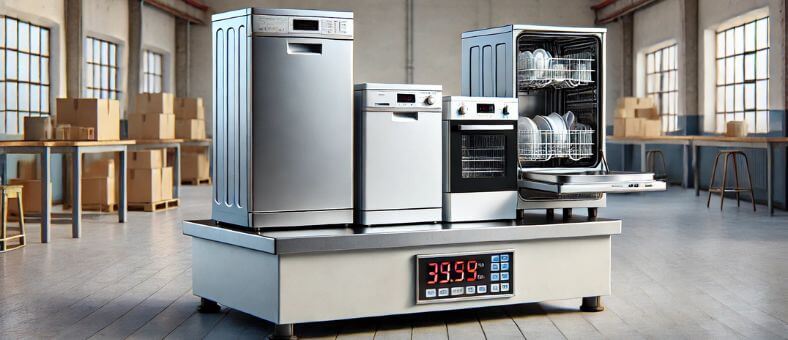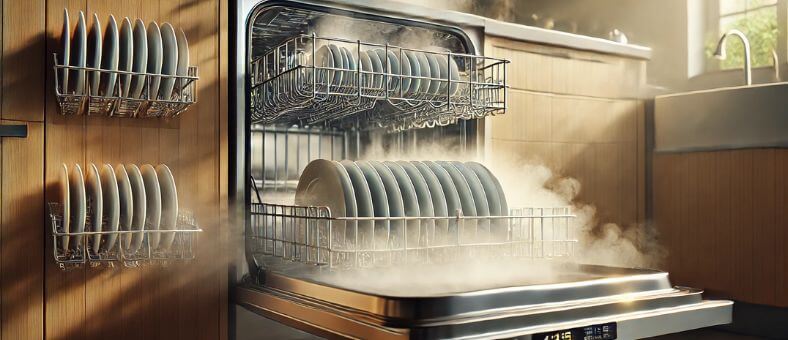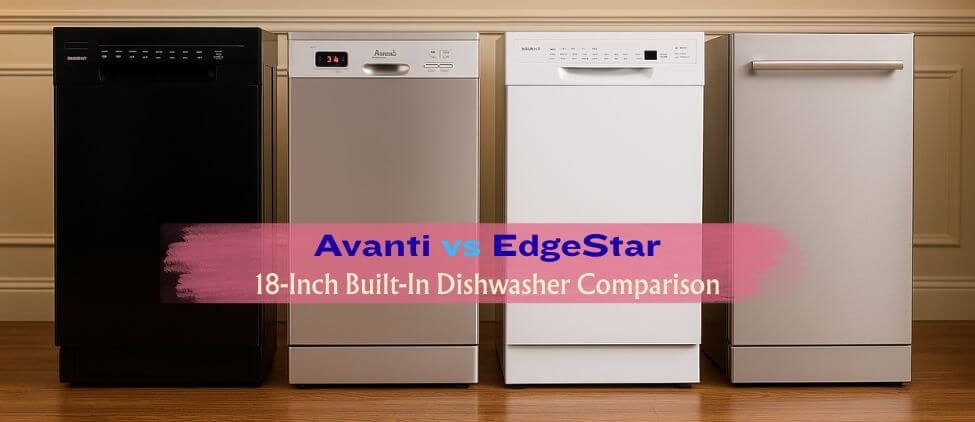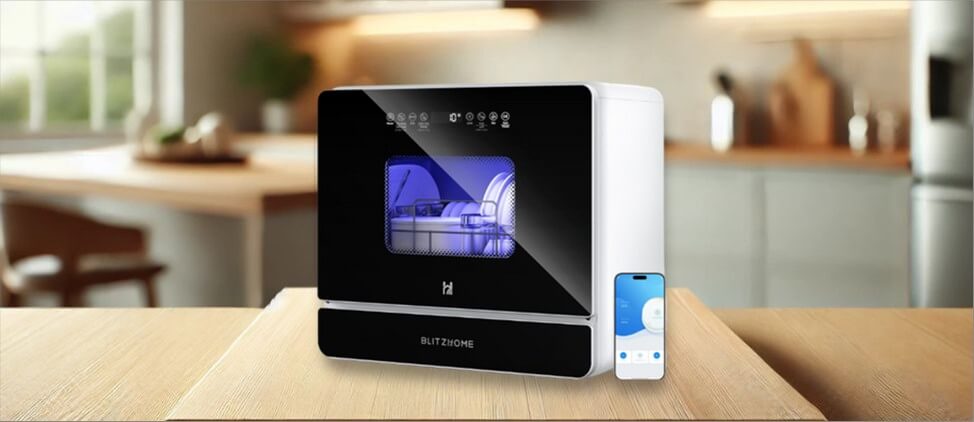While looking around a friend’s kitchen, have you ever been curious, “Wait, where’s their dishwasher?” only to be amazed when they wheeled out a compact, efficient machine? That’s probably when you thought, “What is a portable dishwasher?” Surprise, surprise! These nifty machines are revolutionizing kitchens everywhere.
A portable dishwasher isn’t just any appliance; it’s a mobile wonder for those kitchens where space is a premium or for folks who love flexibility. Imagine having the power to clear up a dinner mess without permanently giving up square footage in your kitchen. It’s like having a secret superhero gadget – right in your home!
If the idea of a space-saving, efficient dishwasher has your curiosity peaked, you’re in for a treat. Dive in with us as we uncover the magic behind portable dishwashers, their unique features, and why you should consider getting one for your home. Trust us; this is a kitchen game-changer you’ll want to know more about!
Portable Dishwashers: Then vs. Now
Did you know that the portable dishwashers of today are miles ahead of their ancestors. They’re sleek, efficient, and feature-packed, all thanks to decades of relentless innovation. It’s like comparing a bicycle to a sports car!
Table of Contents
How does a portable dishwasher work?
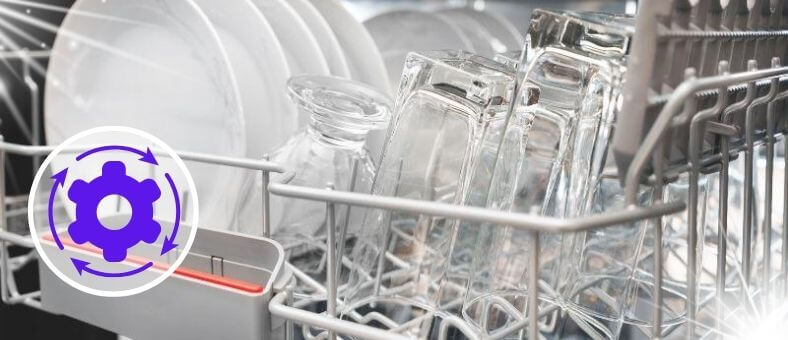
A portable dishwasher works like a built-in model but with a different water supply and drainage system. Here are 7 step-by-step breakdowns of its operation:
Step # 01: Connection to Water Supply
The dishwasher is moved close to the sink. The inlet hose, which is attached to the unit, is connected to the kitchen faucet. Most models come with a quick-connect adapter that fits onto most taps.
Step # 02: Filling the Dishwasher
First, the dishes should be loaded onto the racks. Next, add detergent to the dispenser. Then, select the desired wash cycle and start the dishwasher.
Step # 03: Wash Cycle
Water flows from the faucet, through the inlet hose, and into the dishwasher. The dishwasher heats the water to the required temperature. The spray arms distribute the water mixed with detergent to clean the dishes.
Step # 04: Drain Cycle
After cleaning the dishes, the dirty water is pumped out of the dishwasher, through the drain hose, and into the sink drain.
Step # 05: Rinse Cycle
The dishwasher is filled with clean water, which is sprayed onto the dishes to rinse off the detergent.
Step # 06: Final Drain Cycle
After rinsing, the dishwasher drains the last time. The dishes are then dried by the heat generated during the wash and rinse cycles or by a built-in heating element.
Step # 07: Disconnecting the Dishwasher
Once the cycle is finished, the hoses are disconnected from the faucet, and the dishwasher can be rolled back to its storage spot.
Portable dishwashers offer a practical and efficient solution for individuals who require the flexibility of moving their dishwasher as needed or lack the space to accommodate a built-in appliance.
How to use a portable dishwasher?
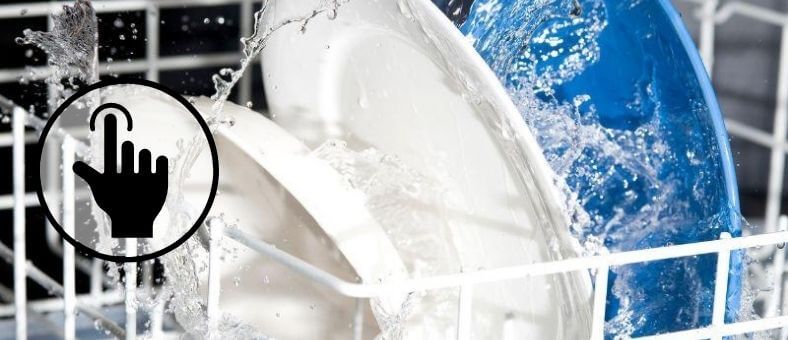
Operating a portable dishwasher is simple and can be done in four steps. Here’s how to do it:
Step # 01: Turn on Hot Water
Ensure your faucet is set to dispense hot water. The water temperature significantly impacts the effectiveness of the dishwasher cycle.
Step # 02: Check Hose Connection
Examine the hoses attached to your portable dishwasher. Ensure they are securely connected and show no wear or leakage.
Step # 03: Connect Hose to Faucet
Connect the dishwasher’s water supply hose to the faucet using the adapter provided by the unit. Make sure the connection is secure to prevent any leaks during operation.
Step # 04: Start the Dishwasher Cycle
Load your dishes, add the recommended amount of dishwasher detergent, select your preferred cycle, and start the dishwasher. Make sure the dishwasher is fully loaded but not overloaded to maximize efficiency and ensure all dishes get cleaned.
How to Choose a Portable Dishwasher
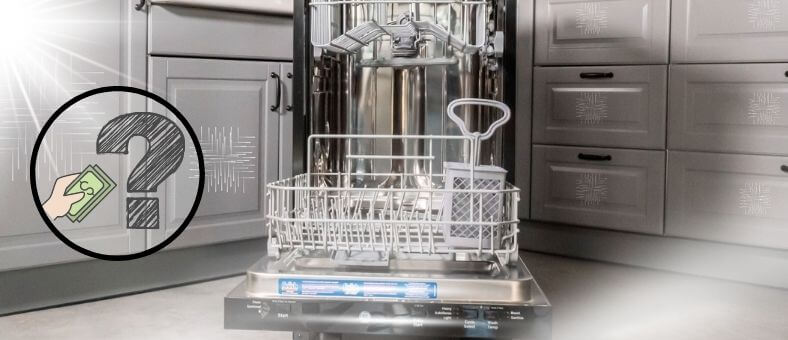
Making the right choice when selecting a portable dishwasher requires careful consideration of several vital factors that will ensure it meets your specific needs and lifestyle. So get ready for an empowering guide to help you make an informed decision!
- Measure Your Space: Ensure the dishwasher fits in both storage and operational areas by measuring the intended space. Learn more about choosing the right size with our guide.
- Assess Your Capacity Needs: Consider the volume and frequency of dishes you need to wash to determine the appropriate size and capacity.
- Check the Water Connection: Ensure the dishwasher can connect to your kitchen faucet and handle efficient drainage.
- Consider Energy and Water Efficiency: Opt for models with high energy and water efficiency ratings to reduce utility costs and support environmental sustainability. Discover the 5 best portable dishwashers that excel in efficiency.
- Evaluate Noise Levels: If noise is a concern, select a model known for quiet operation.
- Look at Cycle Options: Choose a dishwasher that offers wash and dry cycles that suit your specific dishwashing needs. Learn more about dishwasher cycles and settings to understand which options are best for you.
- Understand the Cost: Account for both upfront and ongoing operational costs, including water and electricity usage.
- Read Reviews and Ratings: Gain insights into performance, durability, and user-friendliness by checking online reviews and ratings.
- Consider the Warranty: Choose a model with a comprehensive warranty to protect your investment.
- Conduct Thorough Research: Compare different models, considering your needs, space limitations, and budget before making a decision.
What are the benefits of a portable dishwasher?

Portable dishwashers have several benefits, making them a practical choice for many households. Here are some of the primary advantages:
Flexibility and Mobility
The main benefit of a portable dishwasher is its ability to move around easily. It can be rolled away when unused; this product is suitable for small kitchens with limited space. If you move or rearrange your kitchen, the dishwasher can quickly move with you.
Ease of Installation
Portable dishwashers do not require permanent installation. For them to work, they must be connected to a faucet and plugged into an electrical outlet, making them a suitable option for renters or those who can’t modify their kitchen layout.
Additional Counter Space
Many portable dishwashers have a countertop, providing extra prep space in the kitchen. This can be particularly beneficial in smaller kitchens where counter space is premium.
Cost-Effective
In general, portable dishwashers are less expensive than built-in models, both in terms of initial purchase price and installation costs.
Various Sizes and Features
Portable dishwashers come in different sizes, from compact to full-sized models, and often include multiple wash cycles and other features, offering a range of options to suit various needs.
Conserves Water
Compared to hand washing dishes, using a dishwasher can help conserve water. Some portable models are also designed to be energy-efficient, saving resources and reducing utility bills.
Portable dishwasher features
Portable dishwashers come with many features contributing to their convenience and efficiency. Here are some key features you should look for when considering a portable dishwasher:
Capacity
Portable dishwashers typically hold between 4 and 12 place settings. Smaller countertop models may be more appropriate for single individuals or couples. In contrast, freestanding models can handle the dish loads of larger households.
Cycles
Most portable dishwashers have multiple wash cycles, including normal, heavy, light, rinse-only, and even energy-saving options. Some may also have unique features like a sanitizing option or a delayed start function.
Noise Level
Many newer models are designed to operate quietly, so you don’t have to worry about the dishwasher noise overwhelming your kitchen or living space.
Mobility
A distinguishing feature of portable dishwashers is their mobility. Freestanding models often come with wheels for easy movement, and countertop models are lightweight enough to be moved as needed.
Easy Installation
Portable dishwashers are typically easy to install, often only requiring a connection to the kitchen faucet and a standard electrical outlet.
Energy Efficiency
Many portable dishwashers are designed to be energy efficient and may even have Energy Star ratings, which can save you money on utility bills over time.
Design
The design of portable dishwashers can vary from sleek and modern to more classic looks. Some models even offer a butcher block top to provide extra counter space in your kitchen.
What are the Disadvantages of a Portable dishwasher?
While portable dishwashers offer many benefits, they also come with some potential drawbacks, which include:
Limited Capacity
Compared to built-in models, portable dishwashers usually have a smaller capacity, which may not be suitable for larger families or those who cook a lot and have many dishes to clean regularly.
Mobility Issues
Although their portability can be a significant advantage, moving them around can be a hassle, particularly for the larger, freestanding models. Hooking and unhooking the unit to the faucet can also be cumbersome for some users.
Space Constraints
While they’re an excellent option for small apartments or kitchens without room for a built-in unit, they still take up floor space in the kitchen when in use. When not in use, they need a storage space which might be a challenge for smaller kitchens.
Compatibility Issues
Portable dishwashers need a compatible faucet for hook-up. Not all kitchen faucets are compatible, and you might need to change your faucet or use an adapter.
Lack of Permanent Connection
A permanent connection can lead to leaking problems if the hoses are correctly attached each time the dishwasher is used.
Aesthetics
For some people, a portable dishwasher may not look as integrated or sleek in the kitchen design as a built-in model.
Noise
Some portable dishwashers, especially older or lower-quality units, may be noisier than built-in models.
Are Portable Dishwashers efficient?
Portable dishwashers can be an efficient choice for many households. They typically use less water than hand-washing, with some models using as little as 3 gallons per load. Moreover, modern portable dishwashers are crafted to conform with Energy Star regulations; hence they consume less energy resulting in a reduced carbon footprint and the possibility of saving on utility expenses. They also save time, as you can engage in other activities while the appliance runs. However, efficiency can vary based on the model and usage habits, and it’s essential to consider Energy Star ratings and other efficiency information when choosing a portable dishwasher.
A Rise in Portable Dishwasher Sales
As of 2023, sales of portable dishwashers saw a 7% increase, highlighting their growing popularity in urban and small households.
Types of Portable Dishwashers
There are two primary types of portable dishwashers: countertop models and freestanding models.
Countertop Portable Dishwashers
These dishwashers are compact and designed to fit on your countertop. They are the smallest dishwashers and are ideal for single individuals or couples or in spaces where a room is at a premium. Countertop dishwashers connect directly to your kitchen faucet and typically have the capacity for 4-6 standard place settings. Read more about the top models in our Countertop Dishwasher Reviews.
Freestanding Portable Dishwashers
Freestanding models are more extensive and equipped with wheels for easy mobility. They often have the capacity of a traditional dishwasher (around 12 standard place settings) and can handle larger dishes. Like countertop models, they connect to the kitchen faucet. In addition, they can be rolled away to a storage location when not in use. Explore the best portable dishwashers here.
Both types have their pros and cons. For example, countertop models are smaller and more economical but may need to provide more capacity for larger households. On the other hand, freestanding models offer more capacity and flexibility but take up more space and are more expensive.
How to hook up a portable dishwasher?

Hooking up a portable dishwasher can be a relatively simple process. To help you out, these are the fundamental steps you should follow:
Step # 01: Position the Dishwasher
Roll the dishwasher over to the sink. Make sure the hoses can reach the faucet.
Step # 02: Connect the Faucet Adapter
If not already installed, attach the faucet adapter that came with your dishwasher to your faucet. This adapter allows the dishwasher to connect to your sink faucet for water supply.
Step # 03: Attach the Hose
Connect the dishwasher’s water supply hose to the faucet adapter. Make sure it’s secure to prevent leaks.
Step # 04: Check the Drain Hose
Ensure the drain hose is directed towards the sink, so the water can drain correctly.
Step # 05: Plug in the Dishwasher
Make sure the power cord reaches the outlet and plug it in. Avoid using an extension cord for safety reasons.
Step # 06: Turn on the Hot Water
Before starting the dishwasher, turn on your hot water. This ensures that the dishwasher begins with hot water, which is necessary for properly cleaning your dishes.
Step # 07: Start the Dishwasher
You can load your dishes and start the dishwasher according to the manufacturer’s instructions.
Remember, you should always follow the specific installation instructions with your dishwasher model. Different models may have slightly different procedures, so referring to your owner’s manual is essential.
Identifying the Ideal Location for Your Portable Dishwasher
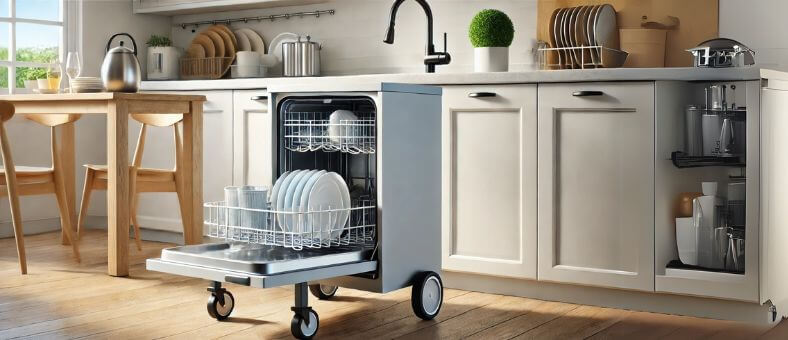
The best place to put a portable dishwasher is a matter of individual preference and space availability. Still, some considerations should guide your decision:
Near the Sink
The most convenient place to use a portable dishwasher is near the kitchen sink since it needs to be connected to a faucet for the water supply and needs access to the sink or another drain for wastewater.
Access to an Outlet
Portable dishwashers must be plugged into an electric outlet. The spot you choose should have easy access to a grounded outlet.
Room to Move
Consider the dishwasher’s mobility. If it’s a freestanding model, it should have enough space to be rolled in and out of its storage spot. Also, ensure enough room to fully open the door and load or unload dishes.
Safety Considerations
Avoid placing the dishwasher in high-traffic areas where it might be in the way or where the hoses and cords could pose a tripping hazard.
Aesthetics
If your dishwasher is visible in your kitchen, consider how it looks in your chosen spot. Some people prefer to keep it hidden in a pantry or utility room when it’s not in use.
The best spot for your portable dishwasher will be a convenient, out-of-the-way location near your kitchen sink, with easy access to an outlet.
Essential Safety Tips for Using Your Portable Dishwasher
- Placement: Ensure the dishwasher is on a flat, sturdy surface to prevent tipping, especially when loaded.
- Check Connections: Verify that all water connections are secure before use to avoid leaks and potential water damage.
- Use Correct Detergents: Utilize only dishwasher-safe detergents to prevent overflow from excessive suds.
- Proper Loading: Follow the manual’s guidelines for loading dishes to prevent breakage during cycles.
- Electrical Safety: Keep the plug dry before connecting to an outlet and avoid using extension cords to prevent overheating and fire risks.
- Maintenance: Regularly clean and inspect your dishwasher for any signs of damage to the unit or its connections.
- Keep Out of Reach: Store the dishwasher and cleaning supplies out of reach of children.
- Use Hot Water: Operate with hot water to effectively kill bacteria and germs.
- Avoid Overloading: Do not overload the dishwasher to ensure effective cleaning and avoid damaging the unit.
- Turn Off After Use: Unplug or turn off the dishwasher when not in use to conserve energy and reduce electrical hazards.
How to clean a portable dishwasher?

It requires regular cleaning to ensure your portable dishwasher’s longevity and optimal performance. To clean your portable dishwasher with efficiency, follow these easy steps.
Clear the Filter
The filter, usually found at the bottom of the dishwasher, traps larger food particles. Remove the filter according to your user manual’s instructions, rinse it under warm water, and scrub gently with a soft brush.
Clean the Spray Arm
Remove any debris clogging the holes in the spray arm. If the arm is removable, take it out and rinse under water to dislodge any trapped particles.
Wipe Down the Interior
Use a soft cloth or sponge with warm water and mild detergent to clean your appliance. Gently wipe down the walls, door, gasket, and other parts that cannot be removed.
Run a Cleaning Cycle
Fill the dishwasher detergent dispenser with a dishwasher-safe cleaning agent or a cup of white vinegar. Run a complete cycle with no dishes. This can help remove grease and limescale.
Deodorize
If your dishwasher has an unpleasant odor, sprinkle baking soda on the bottom and run a short cycle with hot water.
Clean the Exterior
Wipe down the exterior with a damp cloth and mild detergent. Pay special attention to the controls and handles.
Always consult your dishwasher’s user manual for specific cleaning instructions, as some models may have unique features or requirements. Regularly cleaning your dishwasher can help ensure it continues to wash your dishes effectively.
Unseen Germs in Handwashing
Shockingly, hand washing dishes can leave up to 400 times more bacteria than a portable dishwasher cycle. Safety first!
Wrapping Up: What is a Portable Dishwasher?
Wow, haven’t we had a thrilling journey discovering the world of portable dishwashers? They’re handy, space-saving, and simple, turning dishwashing from a chore into a breeze!
Portable dishwashers come to the rescue whether you live in a small apartment, need an extra hand for your party cleanup, or are a student living in a dorm room. With their nifty size and user-friendly features, they’re just like your superhero dishwashing buddies!
So, next time you’re stuck with a mountain of dirty dishes, remember a portable dishwasher could be your secret weapon. Give it a go, and let it turn your kitchen into a clean, sparkling joy! With a portable dishwasher, the fun doesn’t stop after cooking but continues through cleanup. Let’s make doing dishes a breeze!
Explore Countertop Dishwashers
- COMFEE’ Portable Mini Dishwasher CDC22P2AWW
- NOVETE Portable Countertop Dishwashers TDQR01
- Hermitlux Countertop Dishwasher 5 Washing Programs
- Midea Table-top Countertop Dishwasher MDC22P1ABB
- HAVA Countertop Dishwasher 6 Washing Programs
Discover Freestanding Portable Dishwashers
- SPT SD-9263SS 18″ Wide Portable Dishwasher
- Danby DDW1805EWP Portable Dishwasher
- SPT SD-6513WA 24″ Wide Portable Dishwasher
- SPT SD-9263W 18″ Wide Portable Dishwasher
At WashDryDazzle, we’re dedicated to providing essential insights that make your daily chores effortless. Dive deeper into our comprehensive Dishwasher Education hub to learn more.
Frequently Asked Questions (FAQs)
What are the main differences between portable and built-in dishwashers?
The main differences lie in size, installation, and mobility. Portable dishwashers are standalone units that can be moved around your kitchen or stored away when unused. They’re great for small spaces or homes without the ability to install a built-in unit. On the other hand, built-in dishwashers are permanently installed into your kitchen cabinetry. They are larger and can handle more dishes but require a dedicated space in your kitchen layout.
Which brands are considered the best for portable dishwashers?
: Some top brands that manufacture portable dishwashers include GE Appliances, Whirlpool, Danby, and SPT. These brands are known for their quality, performance, and durability.
How should I maintain my portable dishwasher?
Regular cleaning is essential. Ensure the spray arm and filter are debris-free. Run a cleaning cycle with a dishwasher-safe cleaning agent or white vinegar. Also, inspect and clean the seals to prevent leaks, and ensure the hoses are in good condition.
How much does a portable dishwasher typically cost?
Prices vary depending on the portable dishwasher’s brand, size, and features. As of my knowledge cutoff in September 2021, they typically range from $200 for smaller, more basic models to $700 or more for larger models with more features.
Are portable dishwashers loud when operating?
The noise level of a portable dishwasher depends on the specific model. Most modern dishwashers are designed to operate quietly, generally between 45 to 60 decibels. Always check the noise level rating in the product specifications before buying.
What type of detergent should I use in my portable dishwasher?
High-efficiency dishwasher detergents are typically recommended. Brands like Cascade, Finish, and Seventh Generation offer detergents that work well in portable dishwashers. However, always check your user manual for the manufacturer’s recommendations.
How long does a portable dishwasher typically last?
The lifespan of a portable dishwasher varies based on how well it’s maintained, the quality of the unit, and how frequently it’s used. However, on average, you can expect a portable dishwasher to last anywhere from 7 to 12 years.
How much water does a portable dishwasher use?
The amount of water used can vary between models and cycles. On average, portable dishwashers for energy-efficient models can use around 3 to 4 gallons of water per load. Always refer to the specific product’s manual for more accurate information.




